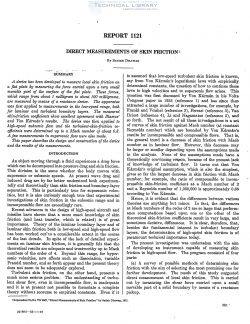naca-report-1121
- Version
- 140 Downloads
- 2.65 MB File Size
- 1 File Count
- October 27, 2016 Create Date
- October 27, 2016 Last Updated
National Advisory Committee for Aeronautics, Report - Direct Measurements of Skin Friction

An object moving through a fluid experiences a drag force
which can be decomposed into pressure drag and skin friction.
This division is the same whether the body moves with
supersonic or subsonic speeds. At present wave drag and
induced drag are by far better understood both experimen—
tally and theoretically than skin friction and boundary-layer
separation. This is particularly true for supersonic veloc—
ities, but it is also curiously enough true that experimean
investigatiOns of skin friction in the subsonic range and in
incompressible flow are exceedingly rare.
Recent advances in the design of highspeed aircraft and
missiles have shown that a more exact knowledge of skin
friction (and heat transfer, which is related) is of great
importance. Theory of the laminar boundary layer and of
laminar skin friction both in low—speed and high-speed flow
has been worked ou‘t‘to‘a considerable extent in the course
of the last decade. In spite of the lack of detailed experi—
ments on laminar skin friction, it is generally felt that the
theoretical results are adequate and trustworthy up to Mach
numbers of the order of 4. Beyond this range, for hyper-
sonic velocities, new effects such as dissociation, variable
Prandtl number, and so forth appear and the present theory
does not seem to be adequately explored.
Turbulent skin friction, on the other hand, presents a
much more serious problem. The understanding of turbu-
lent shear flow, even in incompressible flow, is inadequate
and it is at present not possible to formulate a complete
theory Without recourse to empirical constants. Even if it
is assumed that low-speed turbulent skin friction is known,
say from Von Karman’s logarithmic laws With empirically
determined constants, the question of how to continue these
laws to high velocities and to supersonic _flow arises. This
question was first discussed by Von Karmfin in his Volta
Congress paper in 1935 (reference 1) and has since then
attracted a large number of investigations, for example, by
Frankl and Voishel (reference 2), Ferrari (reference 3) ; Van
Driest (reference 4), Li and Nagamatsu (reference 5), and
so forth.
| File | Action |
|---|---|
| naca-report-1121 Direct Measurements of Skin Friction.pdf | Download |

Comment On This Post